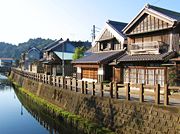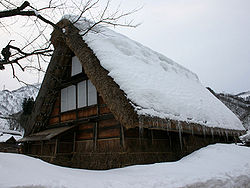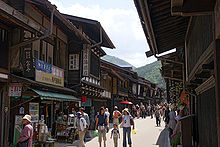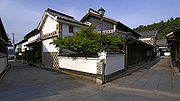
Groups of Traditional Buildings
Encyclopedia
The Japanese government
's Agency for Cultural Affairs
recognizes and protects the country's cultural properties
under the Law for the Protection of Cultural Properties. is a category introduced by a 1975 amendment of the law which mandates the protection of groups of traditional buildings which, together with their environment, form a beautiful scenery. They can be post towns, castle towns, mining towns, merchant quarters, ports, farming or fishing villages, etc.
Municipalities can designate items of particular importance as and approve measures to protect them. Items of even higher importance are then designated by the central government. The Agency for Cultural Affairs then provides guidance, advice, and funds for repairs and other work. Additional support is given in the form of preferential tax treatment.
As of September 8, 2011, 91 districts have been classified as Important Preservation Districts for Groups of Traditional Buildings, and about 15,300 buildings have been thus designated as Traditional Buildings.
Government of Japan
The government of Japan is a constitutional monarchy where the power of the Emperor is very limited. As a ceremonial figurehead, he is defined by the 1947 constitution as "the symbol of the state and of the unity of the people". Power is held chiefly by the Prime Minister of Japan and other elected...
's Agency for Cultural Affairs
Agency for Cultural Affairs
The is a special body of the Japanese Ministry of Education . It was set up in 1968 to promote Japanese arts and culture. As of April 2007, it is led by the Commissioner for Cultural Affairs, Tamotsu Aoki....
recognizes and protects the country's cultural properties
Cultural Properties of Japan
As defined by the Japanese government's Agency for Cultural Affairs, the are tangible properties and intangible properties created or developed in JapanDespite the official definition, some Cultural Properties of Japan were created in China, Korea or other...
under the Law for the Protection of Cultural Properties. is a category introduced by a 1975 amendment of the law which mandates the protection of groups of traditional buildings which, together with their environment, form a beautiful scenery. They can be post towns, castle towns, mining towns, merchant quarters, ports, farming or fishing villages, etc.
Municipalities can designate items of particular importance as and approve measures to protect them. Items of even higher importance are then designated by the central government. The Agency for Cultural Affairs then provides guidance, advice, and funds for repairs and other work. Additional support is given in the form of preferential tax treatment.
As of September 8, 2011, 91 districts have been classified as Important Preservation Districts for Groups of Traditional Buildings, and about 15,300 buildings have been thus designated as Traditional Buildings.
Criteria
'Important Preservation Districts' for Groups of Traditional Buildings are designated according to one of three criteria:- Groups of traditional buildings that show excellent design as a whole
- Groups of traditional buildings and land distribution that preserve the old state of affairs well
- Groups of traditional buildings and their surrounding environment that show remarkable regional characteristics
Usage
The table's columns (except for Remarks and Images) are sortable pressing the arrows symbols. The following gives an overview of what is included in the table and how the sorting works.- Name: name of the important preservation district as registered in the Database of National Cultural Properties
- Type: type of the district (warrior / merchant / pleasure /... quarter, post town, mountain villlage, mine town,...)
- Criteria: number of criterion under which the district is designated
- Area: area covered
- Remarks: general remarks
- Location: "town-name prefecture-name"; The column entries sort as "prefecture-name town-name".
- Images: picture of the structure
List
| Name | Type | Criteria | Area | Remarks | Location | Images |
|---|---|---|---|---|---|---|
| port quarter | 3 | |||||
| warrior quarter | 2 | |||||
| merchant quarter | 1 | |||||
| warrior quarter | 3 | |||||
| warrior quarter | 2 | |||||
| post town Shukuba were post stations during the Edo period in Japan, generally located on one of the Edo Five Routes or one of its sub-routes. They were also called shukueki . These post stations were places where travelers could rest on their journey around the nation... |
2 | Part of the Aizu Nishi Kaidō | ||||
| mountain village | 3 | |||||
| temple town, zaigō town | 2 | |||||
| mountain village and sericulture Sericulture Sericulture, or silk farming, is the rearing of silkworms for the production of raw silk.Although there are several commercial species of silkworms, Bombyx mori is the most widely used and intensively studied. According to Confucian texts, the discovery of silk production by B... community |
3 | |||||
| merchant quarter | 1 | |||||
| merchant quarter | 3 |  |
||||
| port quarter | 3 | |||||
| merchant quarter | 1 | |||||
| mountain village | 3 | Part of the World Heritage Site World Heritage Site A UNESCO World Heritage Site is a place that is listed by the UNESCO as of special cultural or physical significance... Historic Villages of Shirakawa-gō and Gokayama Historic Villages of Shirakawa-go and Gokayama The Historic Villages of Shirakawa-gō and Gokayama are one of Japan's UNESCO World Heritage Sites. The site is located in the Shogawa river valley stretching across the border of Gifu and Toyama Prefectures in northern Japan. Shirakawa-gō is located in the village of Shirakawa in Gifu Prefecture... |
 |
|||
| mountain village | 3 | Part of the World Heritage Site World Heritage Site A UNESCO World Heritage Site is a place that is listed by the UNESCO as of special cultural or physical significance... Historic Villages of Shirakawa-gō and Gokayama Historic Villages of Shirakawa-go and Gokayama The Historic Villages of Shirakawa-gō and Gokayama are one of Japan's UNESCO World Heritage Sites. The site is located in the Shogawa river valley stretching across the border of Gifu and Toyama Prefectures in northern Japan. Shirakawa-gō is located in the village of Shirakawa in Gifu Prefecture... |
||||
| ship-owner quarter | 2 | |||||
| pleasure quarter | 1 | |||||
| pleasure quarter | 1 | |||||
| ship-owner quarter | 2 | |||||
| post town Shukuba were post stations during the Edo period in Japan, generally located on one of the Edo Five Routes or one of its sub-routes. They were also called shukueki . These post stations were places where travelers could rest on their journey around the nation... |
3 | Part of the Saba Kaidō | ||||
| merchant and pleasure quarter | 2 | |||||
| post town for pilgrims | 3 | |||||
| post town Shukuba were post stations during the Edo period in Japan, generally located on one of the Edo Five Routes or one of its sub-routes. They were also called shukueki . These post stations were places where travelers could rest on their journey around the nation... |
3 | One of the 69 Stations of the Nakasendō 69 Stations of the Nakasendo The are the rest areas along the Nakasendō, which ran from Nihonbashi in Edo to Sanjō Ōhashi in Kyoto. The route stretched approximately and was an alternate trade route to the Tōkaidō.-Stations of the Nakasendō:... and part of the Kisoji Kisoji The was an old trade route in the Kiso Valley that stretched from Niekawa-juku in Nagano Prefecture to Magome-juku in Gifu Prefecture. There were eleven resting spots along the route, all of which became part of the Nakasendō when it was established... |
 |
|||
| lacquerware Japanese lacquerware Japanese lacquerware is a broad category of fine and decorative arts, as lacquer has been used in paintings, prints, and on a wide variety of objects from Buddha statues to bento boxes for food.A number of terms are used in Japanese to refer to lacquerware... town |
2 | |||||
| post town and sericulture Sericulture Sericulture, or silk farming, is the rearing of silkworms for the production of raw silk.Although there are several commercial species of silkworms, Bombyx mori is the most widely used and intensively studied. According to Confucian texts, the discovery of silk production by B... community |
1 | Part of the Hokkoku Kaidō Hokkoku Kaido The was a highway in Japan during the Edo period. It was a secondary route, ranked below the Edo Five Routes in importance. Because it was developed for travelers going to Zenkō-ji, it was also called Zenkō-ji Kaidō . It stretched from the Nakasendō's Oiwake-juku to the Hokurikudō's Takada-shuku... |
||||
| post town Shukuba were post stations during the Edo period in Japan, generally located on one of the Edo Five Routes or one of its sub-routes. They were also called shukueki . These post stations were places where travelers could rest on their journey around the nation... |
3 | One of the 69 Stations of the Nakasendō 69 Stations of the Nakasendo The are the rest areas along the Nakasendō, which ran from Nihonbashi in Edo to Sanjō Ōhashi in Kyoto. The route stretched approximately and was an alternate trade route to the Tōkaidō.-Stations of the Nakasendō:... |
||||
| mountain village | 3 | |||||
| merchant quarter | 3 | |||||
| merchant quarter | 1 | |||||
| merchant quarter | 1 | |||||
| mountain village | 3 | Part of the World Heritage Site World Heritage Site A UNESCO World Heritage Site is a place that is listed by the UNESCO as of special cultural or physical significance... Historic Villages of Shirakawa-gō and Gokayama Historic Villages of Shirakawa-go and Gokayama The Historic Villages of Shirakawa-gō and Gokayama are one of Japan's UNESCO World Heritage Sites. The site is located in the Shogawa river valley stretching across the border of Gifu and Toyama Prefectures in northern Japan. Shirakawa-gō is located in the village of Shirakawa in Gifu Prefecture... |
||||
| merchant quarter | 1 | |||||
| merchant quarter | 1 | |||||
| post town Shukuba were post stations during the Edo period in Japan, generally located on one of the Edo Five Routes or one of its sub-routes. They were also called shukueki . These post stations were places where travelers could rest on their journey around the nation... |
3 | One of the 53 Stations of the Tōkaidō 53 Stations of the Tokaido The are the rest areas along the Tōkaidō, which was a coastal route that ran from Nihonbashi in Edo to Sanjō Ōhashi in Kyoto.-Stations of the Tōkaidō:... |
||||
| merchant quarter | 1 | |||||
| temple town | 3 | |||||
| farming village | 3 | |||||
| fishing village | 3 | |||||
| pleasure quarter | 1 | |||||
| temple town | 3 | |||||
| temple town | 3 | |||||
| shrine quarter | 2 | |||||
| mountain village | 3 | |||||
| textile town | 2 | |||||
| > temple town, zaigō townDuring the Edo period | 1 | |||||
| castle town | 2 | |||||
| port quarter | 1 | |||||
| castle town | 2 | |||||
| merchant quarter | 1 | |||||
| temple town, zaigō town | 1 | |||||
| merchant quarter | 1 | |||||
| brewers quarter | 2 | |||||
| merchant quarter | 1 |  |
||||
| port quarter, hot-spring town | 2 | Part of the World Heritage Site World Heritage Site A UNESCO World Heritage Site is a place that is listed by the UNESCO as of special cultural or physical significance... Iwami Ginzan Silver Mine and its Cultural Landscape |
||||
| mining town | 3 | Part of the World Heritage Site World Heritage Site A UNESCO World Heritage Site is a place that is listed by the UNESCO as of special cultural or physical significance... Iwami Ginzan Silver Mine and its Cultural Landscape |
||||
| mining town | 3 | |||||
| merchant quarter | 1 | |||||
| port quarter | 2 | |||||
| salt works town | 1 | |||||
| port quarter | 2 | |||||
| warrior quarter | 2 | |||||
| warrior quarter | 2 | |||||
| post town Shukuba were post stations during the Edo period in Japan, generally located on one of the Edo Five Routes or one of its sub-routes. They were also called shukueki . These post stations were places where travelers could rest on their journey around the nation... |
2 | |||||
| merchant quarter | 1 | |||||
| mountain village | 3 | |||||
| merchant quarter | 1 | |||||
| port quarter | 3 |  |
||||
| zaigō town | 2 | |||||
| wax maker quarter | 3 | |||||
| zaigō town | 1 | |||||
| zaigō town | 3 | |||||
| zaigō town | 3 | |||||
| castle town | 2 | |||||
| merchant quarter | 2 | |||||
| merchant quarter | 2 | |||||
| port quarter and zaigō town | 2 | |||||
| brewers town | 1 | |||||
| porcelain-maker town | 3 | |||||
| warrior quarter | 2 | |||||
| port quarter | 2 | |||||
| port quarter | 2 | |||||
| port quarter | 2 | |||||
| merchant quarter | 2 | |||||
| mountain village | 3 | |||||
| port quarter | 2 | |||||
| warrior quarter | 2 | |||||
| warrior quarter | 2 | |||||
| warrior quarter | 2 | |||||
| warrior quarter | 2 | |||||
| farming village | 3 | |||||
| farming village | 3 |  |
See also
- Tourism in Japan

